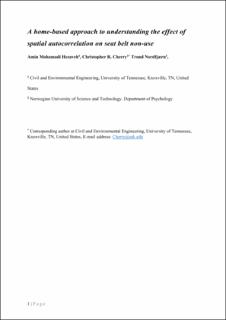| dc.contributor.author | Hezaveh, Amin | |
| dc.contributor.author | Cherry, Christopher | |
| dc.contributor.author | Nordfjærn, Trond | |
| dc.date.accessioned | 2022-09-08T12:35:12Z | |
| dc.date.available | 2022-09-08T12:35:12Z | |
| dc.date.created | 2020-12-24T00:42:39Z | |
| dc.date.issued | 2021 | |
| dc.identifier.citation | Transportation Research Part F: Traffic Psychology and Behaviour. 2021, 77 156-167. | en_US |
| dc.identifier.issn | 1369-8478 | |
| dc.identifier.uri | https://hdl.handle.net/11250/3016638 | |
| dc.description.abstract | Roadside observations indicate that seat belt use rates are often spatially correlated with nearby areas. However, very few studies have examined the effects of spatial autocorrelation on seat belt use. This study used exploratory spatial data analysis (ESDA) to explore spatial autocorrelation in Tennessee, which has a lower seat belt use than the United States national average. We geocoded home-addresses of vehicle occupants involved in traffic crashes between 2014 and 16 (n = 1,251,901) and projected them to the census tract corresponding to their home address. This projection reveals information about the spatial distribution of seat belt non-use and socioeconomics of the areas surrounding the crash victim's home. The presence of highly spatially correlated observations (i.e., a significant positive Moran’s I) suggests that seat belt non-use is not produced solely by the internal structural factors represented in the non-spatial models. ESDA reveals a distinctive regional imprint for spatial autocorrelation, in which Southern-metropolitan areas’ (Southern-MPOs) in Tennessee census tracts have higher than average seat belt non-use compared to Non-Southern-MPOs (16% vs. 9%). The spatial error model was suitable for Non-Southern-MPOs, whereas the spatial lag model was more suitable for Southern MPOs. Comparison of the estimated models indicates that in the Non-Southern MPOs, percentage of the White population, percentage of the population with Bachelor's degree, median household income, vehicle ownership, and population density are significant predictors of seat belt non-use. On the other hand, median household income, vehicle ownership, and percentage of population aged between 16 and 42 years old predict seat belt non-use in Southern MPOs. The study results could be used to identify seat belt non-use clusters at the state level and identify seat belt non-use hot zones. Furthermore, this analysis indicates that the relationship between demographic variables and seat belt non-use varies across regimes. Failing to consider the spatial regimes in the analysis would lead to falsely prioritizing groups prone to seat belt non-use. | en_US |
| dc.language.iso | eng | en_US |
| dc.publisher | Elsevier | en_US |
| dc.rights | Attribution-NonCommercial-NoDerivatives 4.0 Internasjonal | * |
| dc.rights.uri | http://creativecommons.org/licenses/by-nc-nd/4.0/deed.no | * |
| dc.title | A home-based approach to understanding the effect of spatial autocorrelation on seat belt non-use | en_US |
| dc.type | Peer reviewed | en_US |
| dc.type | Journal article | en_US |
| dc.description.version | acceptedVersion | en_US |
| dc.rights.holder | This is the authors' accepted manuscript to an article published by Elsevier. Locked until 24.1.2023 due to copyright restrictions. | en_US |
| dc.source.pagenumber | 156-167 | en_US |
| dc.source.volume | 77 | en_US |
| dc.source.journal | Transportation Research Part F: Traffic Psychology and Behaviour | en_US |
| dc.identifier.doi | 10.1016/j.trf.2020.12.016 | |
| dc.identifier.cristin | 1863154 | |
| cristin.ispublished | true | |
| cristin.fulltext | postprint | |
| cristin.qualitycode | 1 | |

